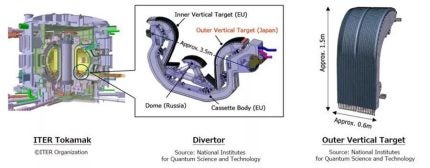
Japan’s Mitsubishi Heavy Industries (MHI) has been awarded a contract to supply an additional 12 outer vertical targets for the divertor to be used in the International Thermonuclear Experimental Reactor (ITER) under construction in France. The contract was awarded by Japan’s National Institutes for Quantum Science & Technology (QST)
This order follows the initial production order for manufacture of six units (Unit 1 – Unit 6) received in 2021. With the additional 12 units (Unit 7 – Unit 18), MHI will be responsible for the manufacture of 18 of the total 54 units. Production of these units will be completed successively, with delivery to QST expected to begin in 2026.
The function of the divertor is to discharge unburned fuel and impurities such as helium (He) in the core plasma generated by the fusion reaction, in order to stably confine the plasma. The heat load on the divertor reaches a maximum of 20MW/square metre. This is approximately 30 times the surface thermal load on the Space Shuttle. High-precision fabrication and processing technology is required as the outer vertical target directly faces the plasma in an extreme environment. It is exposed to the heat load and high energy particle loading from the plasma, and its structure has an extremely complex shape.
MHI also received orders for production for five (of a total of 19) toroidal field (TF) coils, another core component of ITER, all of which were shipped by 2023. In 2022, the company delivered equipment for confirming and demonstrating the safety of the ITER. blanket – one of the components that comprises the inner wall of the fusion reactor.
“Going forward, MHI will continue its efforts for manufacturing of major components such as the divertor and equatorial launcher,” the company said. “In addition, MHI will actively support the design and development of the fusion prototype reactor planned to be constructed following the ITER project, contributing to the realisation of fusion energy.”
ITER is a first-of-a-kind global collaboration with construction funded mainly by the European Union (45.6%) with the remainder shared equally by China, India, Japan, Korea, Russia and the USA (9.1% each). However, in practice, the members deliver little monetary contribution to the project, instead providing ‘in-kind’ contributions of components, systems or buildings. The goal of ITER is to operate at 500 MW (for at least 400 seconds continuously) with 50 MW of plasma heating power input. It is not intended to generate electricity.
Construction began in 2010 and the original 2018 first plasma target date was put back to 2025 by the ITER council in 2016. In June last year, the ITER Organisation was expected to reveal a revised timeline for the project but instead put back by a year an announcement on an updated timeline. The revamped project plan for ITER – with modifications to its configuration, phased installation and new research schedule – is being finalised ahead of being submitted to the ITER Council in June.






